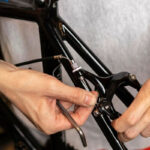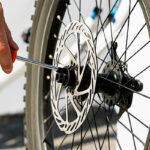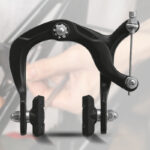Weather conditions can significantly impact the performance of bicycle brakes. As a manufacturer in the bicycle brake industry, S.K. Aggarwal & Co. is dedicated to providing high-quality brakes that perform reliably in all weather conditions. In this blog post, we will explore how different weather factors affect bicycle brake performance and how cyclists can ensure optimal braking, no matter the weather.
Rainy Weather
One of the most challenging weather conditions for bicycle brakes is rain. Wet roads reduce friction between the brake pads and rims or discs, increasing braking distance. This is due to the reduced friction between the brake pads and the wet rims or discs. Additionally, water and road grime can also accumulate on braking surfaces, further reducing stopping power.
To combat these issues, we recommend using brake pads specifically designed for wet conditions. These pads are often made of a softer compound that provides better grip on wet surfaces. Additionally, regular maintenance is crucial in rainy weather to ensure that brake pads and braking surfaces are clean and free of debris.
Cold Weather
Cold temperatures can stiffen brake pads and braking surfaces. In colder conditions, brake pads and braking surfaces can become stiff, reducing their effectiveness. Additionally, hydraulic brake systems may experience a decrease in fluid viscosity, leading to spongy or less responsive braking. To address these challenges, we suggest using brake pads that are formulated for cold weather use. These pads are designed to remain pliable in low temperatures, ensuring consistent braking performance. Hydraulic brake systems may also experience a decrease in fluid viscosity changes in cold weather is essential.
Hot Weather
While hot weather doesn’t pose as many challenges as rain or cold, it can still impact bicycle brake performance. In extreme heat, brake pads and braking surfaces can become overheated, leading to reduced stopping power or brake fade. This is particularly relevant for long descents or heavy braking situations.
To mitigate the effects of hot weather on brakes, we recommend using brake pads with heat-dissipating properties. These pads are designed to manage heat buildup and maintain consistent performance even in high temperatures. Properly adjusting brake systems to minimize pad-to-rim/disc contact during prolonged braking can also help prevent overheating.
Conclusion
Overall, it is essential for cyclists to be aware of how weather conditions can affect bicycle brake performance and to take appropriate measures to ensure safety. Using high-quality brake components designed for specific weather conditions, combined with regular maintenance, cyclists can enjoy reliable braking regardless of the weather.
As a leading manufacturer in the bicycle brake industry, S.K. Aggarwal & Co. is committed to developing innovative brake solutions that address the challenges posed by various weather conditions. Our dedication to quality and performance ensures that cyclists can ride with confidence, knowing that their brakes will deliver consistent and reliable stopping power in any weather.
Read More About “Top 5 Reasons Why V- Brakes Remain Popular Among Cyclists”





